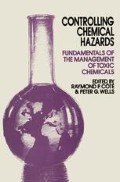Abstract
As indicated in Chapter 1, there are about 100,000 chemical substances presently in commercial use in the world. The number is growing annually. Chemicals are relied upon to maintain the high standard of living in Western countries: solvents, adhesives, polishes, detergents, waxes, cleansers, pesticides, herbicides and fertilizers are just some of the chemicals in use. Many of these products find their way into the environment from the workplace and from the home, through their manufacture, use or disposal. For example, the Great Lakes Water Quality Board has identified over 450 toxic chemicals in the Great Lakes in varying concentrations.
We believe the magnitude of the public risk associated with the toxic chemicals currently is increasing and will continue to do so until we are successful in controlling the introduction of these chemicals into our environment, (us Surgeon General, 1980)
Access this chapter
Tax calculation will be finalised at checkout
Purchases are for personal use only
Preview
Unable to display preview. Download preview PDF.
References
Bonine, J. and McGarity, T. (1984), The Law of Environmental Protection pp. 657–8. ( St Paul, Minnesota: West Publishing Co ).
Castrilli, J. F. (1982), ‘Control of toxic chemicals in Canada: an analysis of law and policy’, Osgoode Hall Law Journal 20, p. 322.
David, D. (1985), ‘The “shot-gun wedding” of science and law: risk assessment and judicial review’, Columbia Journal of Environmental Law 10, p. 67.
Doern, G. B. (1977), Regulatory Processes and Jurisdictional Issues in the Regulation of Hazardous Products in Canada (Background Study No. 41 ) ( Ottawa: Science Council of Canada ).
Doern, G. B. (1982), The Politics of Risk: The Identification of Toxic and Other Hazardous Substances in Canada ( A study for the Royal Commission on Matters of Health and Safety Arising from the use of Asbestos in Ontario ). ( Toronto).
Eec (1978), Council Directives of 20 March, 1978, on Toxic and Dangerous Waste,Official Journal of the European Communities, No. L-84/43, 31.3.78.
Environment Canada (1986), From Cradle to Grave: A Management Approach to Chemicals. ( Ottawa: Supply and Services).
Estrin, David (1986), Handle with Caution: Liability in the Production, Transportation, and Disposal of Dangerous Substances ( Toronto: Carswell).
Finkle, P. (1983), ‘Canadian environmental law in the 80s: problems and perspectives’, Dalhousie Law Journal 7, pp. 257 and 259–60.
Ginsberg, W. and Weiss, L. (1981), ‘Common law liability for toxic torts: a phantom remedy’, Hofstra Law Review 9, 859.
Gresser, J., Fujikura, K. and Morishama, A. (1981), Environmental Law in Japan (Cambridge, Mass.: Mit Press), Ch. 6.
Halter, F. (1987), ‘Regulating information exchange and international trade in pesticides and other toxic substances to meet the needs of developing countries’, Columbia Journal of Environmental Law 12, pp. 1 and 7, note 30.
Kelly, M. (1985), ‘International regulation of transfrontier hazardous waste shipments: a new EEC Environmental Directive’, Texas International Law Journal 21, p. 85.
Kindt, J. W. (1986), ‘International environmental law and policy: an overview of transboundary pollution’, San Diego Law Review 23, p. 583.
Lee, B. L. (n.d.), Coping with Chemicals (Ottawa, Ont.: Environment Canada). Reprinted from a series in the Hamilton Spectator.
Makuch, S. (1986), The Spills Bill: Duties, Rights and Compensation ( Toronto: Butterworth).
Nemetz, P. (1981), Regulation of Toxic Chemicals in the Environment, Working Paper No. 20 ( Ottawa: Economic Council of Canada ).
oecd (1982), Confidentiality of Data and Chemicals Control (Paris: oecd).
Oecd (1985), Resolution of the Council on International Cooperation Concerning Transfrontier Movements of Hazardous Wastes, Oecd Doc. C(85) 100.
Page, T. (1979), ‘A generic view of toxic chemicals and similar risks’, Ecology Law Quarterly 7, p. 207.
Prosser, W. (1971), Handbook of the Law of Torts ( 4th edn ), ( St Paul, Minnesota: West Publishing Co).
Rankin, M. and Finkle, P. (1983), ‘The enforcement of environmental law: taking the environment seriously’, University of British Columbia Law Review 17, p. 34.
Rankin, M. and Leadem, T. (1982), ‘The Fisheries Act and water pollution’, Advocate 40, p. 519.
Schrecker, T. (1984), Political Economy of Environmental Hazards, a study paper for the Law Reform Commission of Canada ( Ottawa: Supply and Services Canada).
Schrecker, T. (1986), Workplace Pollution. Working Paper No. 53. ( Ottawa: Law Reform Commission of Canada ).
Smith, G. P. (1984), ‘The United Nations and the environment: sometimes a great notion?’, Texas International Law Journal 19, 335 at 349, n.64.
Strand, P. (1983), ‘The inapplicability of traditional tort analysis to environmental risks: the example of toxic waste pollution victim compensation’, Stanford Law Review, 43, p. 575.
Trauberman, J. (1983), ‘Statutory reform of “toxic torts”: relieving legal scientific and economic burdens on the chemical victim’, Harvard Environmental Law Review 7, p. 177.
Unep (1984), Environmental Law Guidelines and Principles: No. 6: Banned and Severely
Restricted Chemicals. (New York: United Nations Environment Programme), us Surgeon General (1980), Health Effects of Toxic Pollution. A report from the Surgeon General and a brief review of selected environmental contamination incidents with a potential for health effects, (us Government Publishers Office).
Editor information
Editors and Affiliations
Rights and permissions
Copyright information
© 1991 Raymond P. Côté & Peter G. Wells
About this chapter
Cite this chapter
Rankin, M. (1991). The legal perspective. In: Côté, R.P., Wells, P.G. (eds) Controlling Chemical Hazards. Springer, Dordrecht. https://doi.org/10.1007/978-94-011-6849-6_9
Download citation
DOI: https://doi.org/10.1007/978-94-011-6849-6_9
Publisher Name: Springer, Dordrecht
Print ISBN: 978-94-011-6851-9
Online ISBN: 978-94-011-6849-6
eBook Packages: Springer Book Archive

